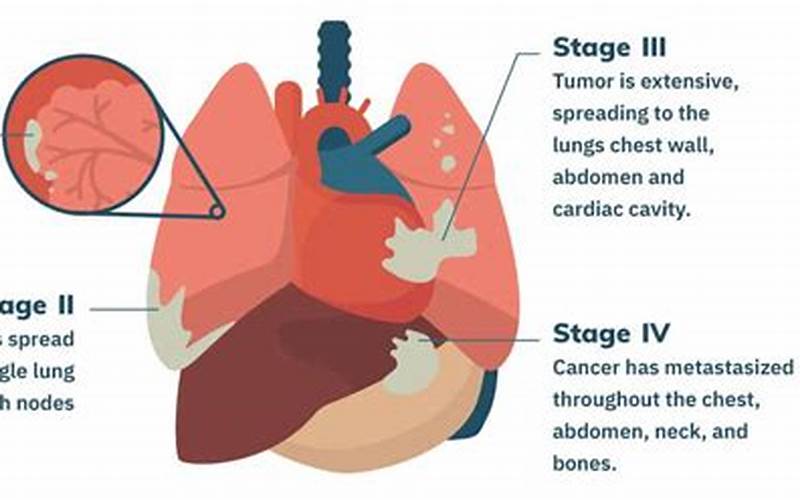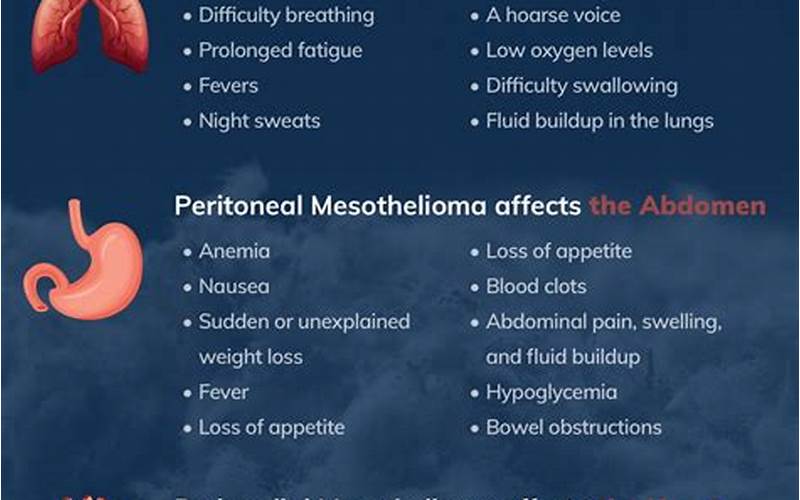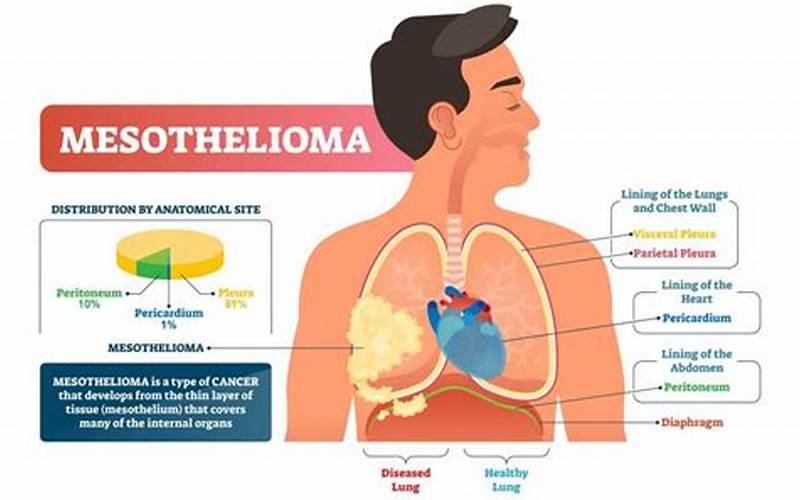Welcome to our comprehensive guide on mesothelioma diagram. In this article, we will delve deeper into what mesothelioma is, how it affects the human body, and how a mesothelioma diagram can help patients and medical professionals understand the disease better. With the help of diagrams and tables, we aim to provide a better understanding of the disease and how it progresses. Let’s get started.
The Basics: What Is Mesothelioma?
Mesothelioma is a rare form of cancer that affects the mesothelium, a thin layer of tissue that lines the organs in the body. It is most commonly found in the lining of the lungs, but can also affect the lining of the abdomen, heart, and testicles. Mesothelioma is caused by exposure to asbestos, a naturally occurring mineral that was widely used in industries such as construction, shipbuilding, and manufacturing due to its heat-resistant properties.
There are three main types of mesothelioma: pleural mesothelioma (affects the lining of the lungs), peritoneal mesothelioma (affects the lining of the abdomen), and pericardial mesothelioma (affects the lining of the heart). The symptoms of mesothelioma can vary depending on the type of mesothelioma and the stage of the disease, but may include shortness of breath, chest pain, abdominal swelling, and weight loss.
Mesothelioma Diagram: Understanding the Disease Better
A mesothelioma diagram can help patients and medical professionals better understand the disease by visualizing how it affects the human body. The following diagram illustrates the different types of mesothelioma and where they are commonly found in the body:
| Type of Mesothelioma |
Location in the Body |
| Pleural Mesothelioma |
Lining of the lungs |
| Peritoneal Mesothelioma |
Lining of the abdomen |
| Pericardial Mesothelioma |
Lining of the heart |
How Does Mesothelioma Progress?
The progression of mesothelioma can vary depending on the type of mesothelioma and the stage of the disease. Mesothelioma is typically classified into four stages, with stage 1 being the earliest and stage 4 being the most advanced. The following diagram illustrates the different stages of mesothelioma:
 Source: bing.com
Source: bing.com
Stage 1 Mesothelioma
In stage 1 mesothelioma, the cancer is localized to the lining of one organ and has not spread to other parts of the body. At this stage, the cancer is usually easier to treat and patients have a better chance of survival.
Stage 2 Mesothelioma
In stage 2 mesothelioma, the cancer has spread beyond the lining of one organ and may have affected nearby lymph nodes. Treatment options may still be available, but the cancer is more difficult to treat than in stage 1.
Stage 3 Mesothelioma
In stage 3 mesothelioma, the cancer has spread to nearby organs and lymph nodes. Treatment options may still be available, but the cancer is more advanced and may be more difficult to treat.
Stage 4 Mesothelioma
In stage 4 mesothelioma, the cancer has spread to other parts of the body, such as the brain, bones, or distant organs. At this stage, treatment options may be limited and the prognosis is poor.
Mesothelioma Diagram: Common Symptoms
The following mesothelioma diagram illustrates the most common symptoms of mesothelioma:
 Source: bing.com
Source: bing.com
Shortness of Breath
Shortness of breath is a common symptom of mesothelioma, especially in cases where the cancer affects the lining of the lungs. As the cancer grows, it can put pressure on the lungs and make it difficult to breathe.
Chest Pain
Chest pain is another common symptom of mesothelioma, especially in cases where the cancer affects the lining of the lungs. The pain may be sharp or dull and may be accompanied by shortness of breath, coughing, and fatigue.
Abdominal Swelling
In cases where mesothelioma affects the lining of the abdomen, patients may experience abdominal swelling, pain, and discomfort. The swelling may be caused by a buildup of fluid in the abdominal cavity.
Mesothelioma Diagram: Treatment Options
The following mesothelioma diagram illustrates the most common treatment options for mesothelioma:
 Source: bing.com
Source: bing.com
Surgery
Surgery is often used in cases where mesothelioma is localized and has not spread to other parts of the body. The goal of surgery is to remove as much of the cancer as possible and improve the patient’s chances of survival.
Chemotherapy
Chemotherapy is a systemic treatment that uses drugs to kill cancer cells throughout the body. It is often used in combination with surgery and radiation therapy to improve the effectiveness of treatment.
Radiation Therapy
Radiation therapy uses high-energy radiation to kill cancer cells. It is often used in combination with surgery and chemotherapy to improve the effectiveness of treatment.
Mesothelioma Diagram: FAQs
What is the prognosis for mesothelioma?
The prognosis for mesothelioma depends on the stage of the disease, the type of mesothelioma, and the patient’s overall health. Early detection and treatment can improve the prognosis, but mesothelioma is often diagnosed at an advanced stage.
What are the risk factors for mesothelioma?
The primary risk factor for mesothelioma is exposure to asbestos. Other risk factors may include age, gender, and a family history of mesothelioma.
How is mesothelioma diagnosed?
Mesothelioma is typically diagnosed through a combination of imaging tests, such as X-rays and CT scans, and a biopsy, which involves removing a small piece of tissue for testing.
What are the treatment options for mesothelioma?
The most common treatment options for mesothelioma include surgery, chemotherapy, and radiation therapy. Other treatments may include immunotherapy, targeted therapy, and palliative care.
What are the side effects of mesothelioma treatment?
The side effects of mesothelioma treatment can vary depending on the type of treatment and the patient’s overall health. Common side effects may include nausea, hair loss, fatigue, and changes in appetite.
Can mesothelioma be prevented?
The primary way to prevent mesothelioma is to avoid exposure to asbestos. If you work in an industry where asbestos may be present, it is important to take proper safety precautions and follow OSHA guidelines to reduce your risk of exposure.
Mesothelioma Diagram: Take Action Today
If you or a loved one has been diagnosed with mesothelioma, it is important to take action and explore your treatment options. Early detection and treatment can improve your chances of survival and quality of life. Contact a qualified oncologist or mesothelioma specialist today to learn more about your options.
Thank you for reading our comprehensive guide on mesothelioma diagram. We hope that this article has provided you with a better understanding of the disease and how it progresses. Remember, early detection and treatment are key to improving your chances of survival. Take action today.
Disclaimer
This article is for informational purposes only and is not intended to
be a substitute for professional medical advice, diagnosis, or treatment. Always seek the advice of your physician or other qualified healthcare provider with any questions you may have regarding a medical condition. Never disregard professional medical advice or delay in seeking it because of something you have read in this article.
Read Also- Testicular Mesothelioma Diagram: Understanding the Rare… Greetings, dear readers! In this article, we will discuss everything you need to know about testicular mesothelioma diagram, a rare but serious cancer affecting the testicles.IntroductionMesothelioma is a type of…
- The Malignant Mesothelioma Diagram: A Comprehensive Overview The Importance of Understanding Malignant Mesothelioma DiagramMalignant mesothelioma is a rare and aggressive form of cancer that affects the thin layer of tissue that lines the lung, chest, and abdomen.…
- Pleural Mesothelioma Diagram: Understanding the Disease and… IntroductionGreetings to all readers! As you may know, mesothelioma is a rare and aggressive form of cancer that affects the lining of the chest and abdomen. Among the various types…
- Cure Mesothelioma Graphics: A Comprehensive Guide 🔍 Understanding Mesothelioma and its Treatment Strategies Mesothelioma is a rare and aggressive form of cancer that affects the thin lining of the lungs, chest, abdomen, or heart. It is…
- The Ultimate Guide to #NAME? - Everything You Need to Know 📚 Are you curious about #NAME? This comprehensive guide has got you covered!Greetings, dear readers! If you landed on this page, you must be intrigued by the topic of #NAME?. Well,…
- CDC90 Expression on Mesothelioma Celllines: Insights on… Greetings, fellow researchers and medical professionals. In this article, we delve into the intricate world of mesothelioma, a rare and aggressive type of cancer that affects the lining of organs,…
- Mesothelioma Meme Black: An In-Depth Look at the Viral… IntroductionHello there, dear reader! We’re sure you’ve heard of mesothelioma meme black by now, as it has become a viral sensation on the internet. From social media platforms to online…
- Human Mesothelioma Cell Lines: Understanding the Disease and… Greetings, dear readers. Mesothelioma is a rare type of cancer that affects the lining of vital organs, such as the lungs and abdomen. This disease is caused by exposure to…
- Dickkopf-1 Antagonizes Wnt Signaling Independent of… IntroductionWelcome to a comprehensive article about dickkopf-1 antagonizes wnt signaling independent of beta-catenin in human mesothelioma. This article is specifically designed to help you understand everything you need to know…
- Mesothelioma Tumor: Understanding the Deadly Cancer 🔍 Uncovering the Essentials of Mesothelioma Tumor 🔍Welcome to our comprehensive journal article about mesothelioma tumor, a devastating cancer that affects the thin layer of tissue that lines the chest…
- here's how i see the difference between madara and… Title: Understanding the Difference between Madara and Mesothelioma: 🕵️♀️ Here's How I See ItIntroduction:As medical conditions continue to evolve and become more complex, it is essential to understand their differences…
- Unlocking the Histology of Pleural Mesothelioma Unlocking the Histology of Pleural Mesothelioma: A Comprehensive GuideWelcome, dear reader! In this article, we will delve into the intricate details of pleural mesothelioma histology. This type of cancer is…
- The Length of Time to Develop Mesothelioma: Unraveling the… Greetings, dear readers! Are you curious about mesothelioma and how long it takes to develop? This deadly cancer has left many people wondering about its causes, symptoms, treatment options, and…
- Non Asbestos Pleural Mesothelioma: Causes, Symptoms, and… IntroductionWelcome to our comprehensive guide on non asbestos pleural mesothelioma. Asbestos is a well-known carcinogen and a leading cause of mesothelioma, but there are other forms of the disease that…
- Mesothelioma: Is There a Background? Uncovering the Truth… Greetings, dear readers! In the world of medicine, mesothelioma is a well-known term. However, for those who are not in the field, it may be a foreign concept. What is…
- What Does Mesothelioma Do to the Lungs? The Devastating Effects of Mesothelioma on the Lungs and Respiratory SystemWelcome to our journal article on mesothelioma and its devastating effects on the lungs and respiratory system. Mesothelioma is a…
- Fabian Johnston MD Mesothelioma: Understanding the Disease… 🔍 Uncovering the Truth About Mesothelioma and Fabian Johnston MDWelcome to our comprehensive guide on mesothelioma and Fabian Johnston MD. Mesothelioma is a rare cancer that affects the mesothelium, a…
- Christopher August Mesothelioma – A Tragic Tale of Asbestos… 🔍 Uncovering the Story of Christopher August MesotheliomaGreetings, dear readers! Today, we delve into the tragic story of Christopher August, who battled mesothelioma, a rare cancer caused by exposure to…
- substances that cause mesothelioma Substances that Cause Mesothelioma: Learn the Dangerous Chemicals ☣️Welcome to our article, where we're going to delve into the dangerous substances that cause mesothelioma. Asbestos is the usual culprit, but…
- The Comprehensive Guide to Mesothelioma Mesothelioma: A Terrifying DiagnosisMesothelioma is a rare, aggressive form of cancer that is caused by exposure to asbestos. The disease affects the mesothelium, the thin layer of tissue that lines…
- Blood Test for Peritoneal Mesothelioma: A Comprehensive… IntroductionGreetings, dear readers! We know how concerning and debilitating peritoneal mesothelioma can be, and we're here to shed light on the significance of blood tests in its diagnosis and management.…
- Mesothelioma and Bradycardia: A Detailed Explanation The Connection Between Mesothelioma and BradycardiaMesothelioma is a rare and aggressive form of cancer that affects the mesothelium, a protective lining that covers most of the body's internal organs. While…
- Mesothelioma Journal: The Comprehensive Guide Introduction: Greetings to Our AudienceHello, and welcome to our comprehensive guide on mesothelioma journal. This article has been created to provide the most accurate and up-to-date information about mesothelioma journal…
- Osteopontin Mesothelioma: Understanding the Link between a… Welcome to our article about Osteopontin Mesothelioma. As you read through this article, we hope to provide you with a comprehensive understanding of the rare cancer that has been linked…
- Non Asbestos Causes of Mesothelioma: Understanding the Risks Greetings, dear readers. The topic we are about to tackle is not something to be taken lightly. Mesothelioma, a rare and aggressive cancer, is commonly associated with exposure to asbestos.…
- NF2-Loss in Mesothelioma: Understanding the Connection Welcome to our informative article about NF2-loss in mesothelioma. In this article, we will discuss the intricate details and complexities of NF2-loss and how it correlates with mesothelioma. We will…
- Christine A. Ciunci MD Mesothelioma: Understanding the… IntroductionGreetings readers! In this article, we will be discussing Christine A. Ciunci MD Mesothelioma, a rare and aggressive form of cancer that affects the mesothelium. Mesothelioma is caused by exposure…
- Mesothelioma PML: What You Need to Know 🚨 A Deadly Disease With No Cure 🚨Greetings, readers! Today, we're going to delve into the world of mesothelioma pml, a rare and deadly form of cancer that affects the…
- Pesticides Mesothelioma Scholarly Association: Understanding… The Impact of Pesticides on Mesothelioma DevelopmentGood day, dear readers. Pesticides have been an essential tool for ensuring food security worldwide. Still, their widespread use has raised concerns about their…
- Site:WellAmerica Mesothelioma: What You Need to Know 🔍 IntroductionWelcome to our comprehensive guide on Site:WellAmerica Mesothelioma. In this article, we will cover everything you need to know about this type of cancer, from the causes and symptoms…